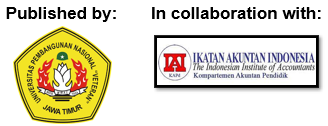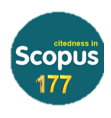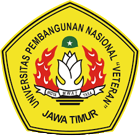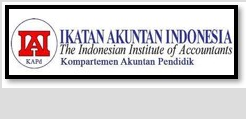Determinants of Mobile Accounting App Adoption by Micro, Small, and Medium Enterprise in Indonesia
DOI:
https://doi.org/10.33005/jasf.v3i1.74Keywords:
Intention, MSMEs, Mobile accounting app, UTAUTAbstract
This study figured out the factors that influence Micro, Small, and Medium Enterprises (MSMEs) in Indonesia to adopt a mobile accounting application as a tool to record business transactions and to prepare financial reports. This research applies the Unified Theory of Acceptance and Use of Technology (UTAUT) with two additional variables, namely perceived risk and perceived trust. Using a combination of purposive, convenience, and snowball sampling techniques, this study distributed questionnaires to MSME owners in Indonesia who know the mobile accounting app. Following that, this study uses the Partial Least Square-Structural Equation Model (PLS-SEM) to analyze the data obtained and to confirm the significance of the causality relationship. Effort expectancy, performance expectancy, social influence, and perceived trust have a significant positive effect on the intention to adopt a mobile accounting app. The study provides knowledge of the factors that influence MSME owners' intentions to choose a mobile accounting app which might help app providers to develop strategies to meet the expectation of MSME owners. This study merely examines the intention to adopt a mobile accounting app, hence further study could examine the user's intention to continue using the mobile accounting app, by using the longitudinal data collection.
Downloads
References
Abrahao, R. de S., Moriguchi, S. N., & Andrade, D. F. (2016). The intention of adoption of mobile payment : An analysis in the light of the Unified Theory of Acceptance and Use of Technology ( UTAUT ). RAI Revista de Administração e Inovação, 13(3), 221–230. https://doi.org/10.1016/j.rai.2016.06.003
AbuShanab, E., & Pearson, J. M. (2007). Internet banking in Jordan The unified theory of acceptance and use of technology (UTAUT) perspective. Journal of Systems and Information Technology, 9(1), 78–97.
Amin, K., Munira, S., Azhar, A., Amin, A., & Karim, M. T. (2016). Factors Affecting Employees' Behavioral Intention to Adopt an Accounting Information System ( AIS ) in Bangladesh. In 19th International Conference on Computer and Information Technology (pp. 501–505).
Bank Indonesia, & Ikatan Akuntan Indonesia. (2016). PTK UMK. Retrieved September 1, 2019, from http://ptk.beit.co.id/
Baptista, G., & Oliveira, T. (2015). Understanding mobile banking: The unified theory of acceptance and use of technology combined with cultural moderators. Computers in Human Behavior, 50, 418–430. https://doi.org/10.1016/j.chb.2015.04.024
Bhatiasevi, V. (2016). An extended UTAUT model to explain the adoption of mobile banking. Information Development, 32(4), 799–814. https://doi.org/10.1177/0266666915570764
Cao, Q., & Niu, X. (2019). Integrating context-awareness and UTAUT to explain Alipay user adoption. International Journal of Industrial Ergonomics, 69(September 2018), 9–13. https://doi.org/10.1016/j.ergon.2018.09.004
Chang, W.-K., & Kin, T.-K. (2004). A Study on the Adoption of Accounting Information Systems in Mandatory Environments : Using TAM and TPB. Journal of Information Technology Applications & Management, 12(1), 174–189.
Chaouali, W., Ben, I., & Souiden, N. (2016). The interplay of counter-conformity motivation, social influence, and trust in customers' intention to adopt Internet banking services: The case of an emerging country. Journal of Retailing and Consumer Services, 28, 209–218. https://doi.org/10.1016/j.jretconser.2015.10.007
Chauhan, S., Gupta, P., & Jaiswal, M. (2018). Factors inhibiting internet adoption by a base of the pyramid in India. Digital Policy, Regulation, and Governance. https://doi.org/10.1108/DPRG-01-2018-0001
Cho, J. (2016). The impact of post-adoption beliefs on the continued use of health apps. International Journal of Medical Informatics, 87, 75–83. https://doi.org/10.1016/j.ijmedinf.2015.12.016
Cruz, P., Neto, L. B. F., Munoz-Gallego, P., & Laukkanen, T. (2010). Mobile banking rollout in emerging markets : evidence from Brazil. International Journal of Bank Marketing, 28(5), 342–371. https://doi.org/10.1108/02652321011064881
Davis, F. D. (1989). Perceived Usefulness, Perceived East of Use, and User Acceptance of Information Technology. MIS Quarterly, 13(3), 319–340. https://doi.org/10.1016/S0305-0483(98)00028-0
Departemen Koperasi RI. (2019). Perkembangan Data Usaha Mikro Kecil Menengah (UMKM) dan Usaha Besar Tahun 2016-2017. Retrieved September 2, 2019, from http://www.depkop.go.id/uploads/laporan/1549946778_UMKM 2016-2017 rev.pdf
Escobar-Rodriguez, T., & Carvajal-Trujillo, E. (2014). Online purchasing tickets for low-cost carriers: An application of the unified theory of acceptance and use of technology (UTAUT) model. Tourism Management, 43, 70–88. https://doi.org/10.1016/j.tourman.2014.01.017
Evon, T. J. L. L. (2016). Behavioral intention to adopt mobile banking among the millennial generation. Young Consumers, 17, 0–5. https://doi.org/http://dx.doi.org/10.1108/YC-07-2015-00537
Farah, M. F., Hasni, M. J. S., & Abbas, A. K. (2018). Mobile-banking adoption : empirical evidence from the banking sector in Pakistan. International Journal of Bank Marketing, 36(7), 1386–1413. https://doi.org/10.1108/IJBM-10-2017-0215
Fazli, M., Sam, M., Hoshino, Y., & Tahir, N. H. (2012). The Adoption of Computerized Accounting System in Small Medium Enterprises in Melaka, Malaysia. International Journal of Business and Management, 7(18), 12–25. https://doi.org/10.5539/ijbm.v7n18p12
Giovanis, A., Assimakopoulos, C., & Sarmaniotis, C. (2018). Adoption of mobile self-service retail banking technologies The role of technology, social. International Journal of Retail & Distribution Management. https://doi.org/10.1108/IJRDM-05-2018-0089
Google Play. (2019). Google Play. Retrieved September 1, 2019, from https://play.google.com/store/apps/collection/cluster?clp=ggELCglha3VudGFuc2k%3D:S:ANO1ljIbQHE&gsr=Cg6CAQsKCWFrdW50YW5zaQ%3D%3D:S:ANO1ljJ_i_U
Greenberg, R., Li, W., & Wing, B. W.-O. (2012). The effect of trust in system reliability on the intention to adopt online accounting systems. International Journal of Accounting & Information Management, 20(4), 363–376.
Hair, J. F., Hult, G. T. M., Ringle, C. M., & Sarstedt, M. (2017). A Primer on Partial Least Squares Structural Equation Modeling ( PLS-SEM ) (Second Edi). Los Angeles: Sage Publications.
Hair, Money, A., Samouel, P., & Page, M. (2007). Research methods for business. Chichester: John Wiley and Sons.
Hair, Ringle, C. M., & Sarstedt, M. (2011). PLS-SEM : Indeed, a Silver Bullet. Journal of Marketing Theory and Practice, 19(2), 139–152. https://doi.org/10.2753/MTP1069-6679190202
Hartono, G. (2019). UMKM Sumbang Rp8.400 Triliun ke Perekonomian Nasional pada 2018. Retrieved September 1, 2019, from https://economy.okezone.com/read/2019/06/19/320/2068296/umkm-sumbang-rp8-400-triliun-ke-perekonomian-nasional-pada-2018
Hofstede-insights. (2019). What About Indonesia? Retrieved March 17, 2020, from https://www.hofstede-insights.com/country/indonesia/
Hoque, R., & Sorwar, G. (2017). Understanding factors influencing the adoption of mHealth by the elderly: An extension of the UTAUT model. International Journal of Medical Informatics, 101(September 2015), 75–84. https://doi.org/10.1016/j.ijmedinf.2017.02.002
Hsiao, K.-L. (2017). What drives smartwatch adoption intention? Comparing Apple and non-Apple watches. Library Hi Tech, 35(2), 186–206.
Ilias, A. (2013). Factor Affecting the Computerised Accounting System (CAS) Usage in Public Sector. Journal of Internet Banking and Commerce, 18(1), 1–29.
Jeon, H. M., Ali, F., & Lee, S. W. (2018). Determinants of consumers' intentions to use smartphone apps for flight ticket bookings. Service Industries Journal, 39(5–6), 385–402. https://doi.org/10.1080/02642069.2018.1437908
Junianto, A. (2018). UMKM Kesulitan Susun Laporan Keuangan. Retrieved September 1, 2019, from https://jogjapolitan.harianjogja.com/read/2018/10/24/511/948228/umkm-kesulitan-susun-laporan-keuangan
Kholid, M. N. (2019). Determinants of intention to use Islamic mobile banking: Evidence from the millennial generation. Jurnal Ekonomi & Keuangan Islam, 5(2), 53–62. https://doi.org/10.20885/JEKI.vol5.iss2.art2
Kumar, J. A., & Bervell, B. (2019). Google Classroom for mobile learning in higher education : Modelling the initial perceptions of students. Education and Information Technologies, 24(2), 1793–1817.
Lee, Y., & Kozar, K. A. (2008). An empirical investigation of anti-spyware software adoption: A multi-theoretical perspective. Information & Management, 45, 109–119. https://doi.org/10.1016/j.im.2008.01.002
Lu, Y., Yang, S., Chau, P. Y. K. & Cao, Y. (2011). Information & Management Dynamics between the trust transfer process and intention to use mobile payment services : A cross-environment perspective. Information & Management, 48(8), 393–403. https://doi.org/10.1016/j.im.2011.09.006
Mahrizal, V. (2017). 80% UMKM Belum Mampu Susun Laporan Keuangan. Retrieved September 1, 2019, from https://jogja.tribunnews.com/2017/10/25/80-umkm-belum-mampu-susun-laporan-keuangan
Mallat, N. (2007). Exploring consumer adoption of mobile payments – A qualitative study. Journal of Strategic Information Systems 16, 16, 413–432. https://doi.org/10.1016/j.jsis.2007.08.001
Mayer, R. C., Davis, J. H., & Schoorman, F. D. (1995). An Integrative Model of Organizational Trust. The Academy of Management Review, 20(3), 709–734.
Mcknight, D. H., Choudhury, V., & Kacmar, C. (2002). Developing and Validating Trust Measures for e-Commerce : An Integrative Typology. Information Systems Research, 13(3), 334–359.
Pavlou, P. A. (2003). Consumer Acceptance of Electronic Commerce : Integrating Trust and Risk with the Technology Acceptance Model. International Journal of Electronic Commerce, 7(3), 101–134.
Rahi, S., Mustafa, M., Mansour, O., Alghizzawi, M., & Alnaser, F. M. (2019). Integration of UTAUT model in internet banking adoption context. Journal of Research in Interactive Marketing, 13(3), 411–435. https://doi.org/10.1108/JRIM-02-2018-0032
Raza, S. A., Shah, N., & Ali, M. (2019). Acceptance of mobile banking in Islamic banks: evidence from modified UTAUT model. Journal of Islamic Marketing, 10(1), 357–376. https://doi.org/10.1108/JIMA-04-2017-0038
Slade, E. L., Dwivedi, Y. K., Piercy, N. C., & Williams, M. D. (2015). Modeling Consumers' Adoption Intentions of Remote Mobile Payments in the United Kingdom : Extending UTAUT with Innovativeness, Risk, and Trust. Psychology and Marketing, 32(August), 860–873. https://doi.org/10.1002/mar
Sultana, J. (2019). Determining the factors that affect the uses of Mobile Cloud Learning ( MCL ) platform Blackboard- a modification of the UTAUT model. Education and Information Technologies.
Suryaningrum, D. H. (2012). Assessing Individual Performance on Information Technology Adoption: A New Competing Model. Global Journal of Business Research, 6 (4), 111-125
Teng, W. (2010). Consumer adoption of PDA phones in Taiwan Weichen. International Journal Mobile Communications, 8(1), 1–20.
Thomas, V. F. (2019). Pemerintah Mengakui Kesulitan untuk Mendata UMKM. Retrieved September 1, 2019, from https://tirto.id/pemerintah-mengakui-kesulitan-untuk-mendata-umkm-eioS
Urumsah, D. (2015). Factors Influencing Consumer to Use E-Service in Indonesian Ariline Companies. Advances in Business Marketing & Purchasing, 23, 5–254.
Venkatesh, V., Morris, M. G., Davis, G. B., & Davis, F. D. (2003). User Acceptance of Information Technology : Toward A Unified View. MIS Quarterly, 27(3), 425–478.
Downloads
Published
How to Cite
Issue
Section
License
Copyright (c) 2020 Muamar Nur Kholid, Shani Alvian, Yunice Karina Tumewang

This work is licensed under a Creative Commons Attribution 4.0 International License.














